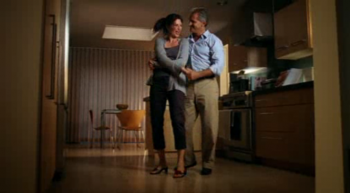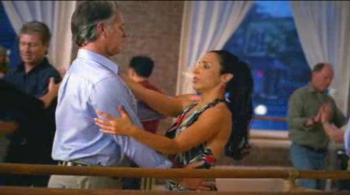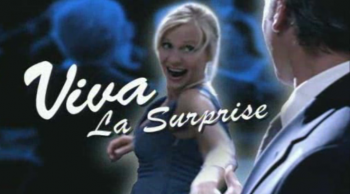Viva Viagra! Or, How Race Dances Around Erectile Dysfunction
Priscilla Peña Ovalle / University of Oregon

Mad Men is the only television show that my Tivo can’t completely record before I begin to watch. This urgency often requires me to pause commercials so I can zip through them. Normally, nothing can delay my fervid appreciation of the dazzling DSF-ing (drinking, smoking and…fornicating) that Mad Men delivers. But this season, I have found myself watching for that blur of perky Viagra-blue lettering during commercial breaks. I am not beckoned by the irony of an all-too appropriate Viagra commercial sandwiched between Mad Men’s hot and heavy scenes. No, I watch the commercials because the brand name medication for erectile dysfunction has yet again returned to that ever-present euphemistic gesture for sex: dancing.
The equation dance=sex has long existed in film and media culture, and most Hollywood musicals feature some form of dance-as-sexual-awakening number between the hero and heroine. These mainstream roles, often white by default and invariably heterosexual, have helped reify dance as a collapsed signifier of racialized sexuality in visual culture: where the white heroine learns to dance, the nonwhite female always already knows how. For one character, dance is a romantic prelude to sex; for the other, dance is a given of her supposed hyper-sexuality. The fabricated white-by-default world of Viagra and its dance/sex equation are also racialized, a fact obscured by Mad Men’s own whiteness.
Viagra commercials make the ubiquitous dance=sex equation quite plain. While drug ads occasionally depict dance to represent vitality, Viagra commercials have long used dance as a metaphor for sex. A decade ago, the first Viagra campaign featured the tag line “Let the Dance Begin” for both television and static print advertisements.1 The current campaign — entitled “Viva Viagra” — brings racialized sexuality to the foreground through language, movement and music even as it visually dissociates this connection through its general casting and narrative. Though now a part of the English lexicon, “Viva!” recalls the Mexican /Spanish-language rallying cry as well as the Elvis film Viva Las Vegas! (1964). Both of these references are racialized and sexualized signifiers that evoke the US Southwest and the so-called sin-city of Vegas. If Elvis seems like a stretch as a racial figure, consider how he helped bring rock-n-roll into the mainstream, not to mention his role as the Native American son of Dolores Del Rio’s character in Flaming Star (1960).
The “Viva Viagra” campaign is composed of five one-minute commercials. This long-play format provides ample time to relay both narrative and pharmaceutical information. While three of these commercials (available at viagra.com) feature dance as a prelude to sex, I am particularly interested in the ways that two of these spots — “Tango” and “Dance Lesson” —collapse racial codes and movement into sexualized metaphor. This collapse is particularly troubling because the commercials depict an otherwise white world, begging the question: do men of color not suffer from erectile dysfunction?

The commercial that initially caught my eye during Mad Men is entitled “Tango”; this commercial is the campaign’s centerpiece and its imagery appears as the interactive opener of the Viagra web site. In “Tango”, an older and attractively fit heterosexual couple sits on a couch; the wife, wedding ring barely visible, flips through magazines while her husband channel surfs. The couple quickly begins a mutual challenge to throw their distractions out the window. One by one, the gender-specific TV remote, magazine pile, golf club and telephone receiver fly onto the perfectly manicured lawn. The couple finally reconnects by dancing a tame tango that evolves into a sort of slow salsa step. This dance is foreplay, literally moving the couple across their spacious living room, through their pristine kitchen and (eventually) safely behind their bedroom door. In the kitchen, the camera lingers on a close-up of their dancing feet: her manicured toes slide through a turn in kicky sandals while his sensible brown shoes anchor her movement…and the announcer catalogues a list of potential side effects (“headaches, flushing, upset stomach and abnormal vision”). The camera captures their moving feet at a soothingly slower frame rate, a technique repeated throughout the campaign to simultaneously enunciate the commercial’s action and distract us from the disclaimers accompanying the seduction scene.
In “Dance Lesson”, a grey-haired gentleman takes classes at a dance school. His dance teacher, an ambiguously ethnic woman with dark hair and big earrings (the Rita Moreno/Rosie Perez costume kit), strongly corrects his movements and posture. The man’s uncertainty is plain and he stumbles about…until a cut replaces the dance teacher with a blonde woman. The man, now a confident dancer, guides and swings his partner across the dance floor. At this moment, the commercial pauses and the phrase “Viva La Surprise” appears in a cursive typeface against the static, blue-tinted image of the dancing couple. Yet again, the commercial’s pace slows as the announcer delivers the details, this time letting the camera linger on a shot of the woman’s diamond wedding ring — a visual confirmation that Viagra is for committed partners and not one-night-stands.


Because “Viva Viagra” is an overwhelmingly white ad campaign, the use of tango/salsa and the inclusion of an ambiguously ethnic dance instructor suggest that the symbolic interplay between nonwhiteness, dance and sexuality is a significant component of the campaign’s message. Use of the word “Viva” and the Spanish preposition “La” underscore these connections. Like the dance=sex equation, “Viva Viagra” reminds us that dance is also frequently and easily used to evoke race and racialized sexuality — and vice versa. The flirty and fun message of the “Viva Viagra” campaign works so well because US visual culture has repeatedly tangled its racialized and sexualized signifiers, especially in depictions of dance. Representations of dance, race and sexuality have so commonly intersected that audiences can effortlessly access the meaning of a Viagra commercial without recognizing the discrete symbols that compose the equation.
Both Mad Men and “Viva Viagra” seduce the viewer. It is easy to believe that one critiques patriarchal and institutionally racist practices while the other reinstates them, but “Viva Viagra” has actually made me rethink my Mad Men pleasure. I was already becoming uneasy with my simultaneous adoration of and disdain for the characters in this pre-dominantly white prime-time drama. This concern remains tempered by my deep appreciation for the exquisite thematic subtlety and cynical nostalgia of the show’s writers and performers; in other words, I recognize that my unease is designed by this excellent television drama. But as Viagra becomes a fixture of Mad Men’s season two commercial breaks, I am aggravated by the fact that the attractive older husband in “Tango” could very well be replaced by any of the senior Mad Men engaged in lustful trysts at the Sterling Cooper ad agency.
“Viva Viagra” reminds me that, as a thirty-something Chicana, I am not the target demographic for Viagra — or, perhaps, Mad Men. At the collision point between program and commercial, I am forced to recognize my status as a temporary partner on the floor of the US imaginary and — mid-step — I find that we are dancing around more than erectile dysfunction here. Neither Madison Avenue’s dazzle nor an appropriated Elvis song will convince me otherwise.
Image Credits:
1. Still from “Tango” Viagra Commercial
2. Dancing Couple from “Tango” Viagra Commercial — Dance as Foreplay
3. Make Way For the Real Partner! — The “Dance” Viagra Commercial
Please feel free to comment.
- See Loe, Meika. 2004. The rise of Viagra: how the little blue pill changed sex in America / Meika Loe. New York: New York University Press. [↩]
Great article! I really appreciate your analysis of the Viagra commercials — particularly the way in which the flow of AMC works by concentrating on white-centric ideals both in and out of commercial breaks. Also, you pose the rhetorical question, ” do men of color not suffer from erectile dysfunction?”. It is so interesting how the hyper-masculinity and fetishizing of men of color can be asserted with the absence of men of color on the screen.
The article is interesting – I’ve noticed the same thing about the dance lesson ad (outside of the Mad Men context). The ads have to talk about ‘erectile (dys)function’ but only hint at sex – that’s quite a task. Cialis does it by putting naked men and women in the ads, but in separate bathtubs.
About “The Dance Lesson”… The gender dynamics there are very interesting. In partner dance, both partners have to learn the dance – his new skills only make sense if the wife were already good at ballroom (ahem!) dance. But of course, he gets to lead – he must. In the lesson portion of the ad, the dancing is awkward partly because of the stiff way that they their bodies are held apart, and because although the man has to lead, the instructor is in effect leading (through teaching).
At the wedding reception, the focus is on the wife’s face and body as evidence of the husband’s new skills instead of the body of the husband himself. We see the wife from the husband’s vantage point at times, he’s partially cropped out of the freeze frames, and her body is in front of his, except in the noted scene in which we see her wedding and engagement rings and tennis bracelet (evidence of his economic prowess). Vigorous sex is implied by her ecstatic facial expressions, whirling body and mussed hair. Back to the notion of who is leading, what I find interesting is that after she’s excited enough to pull him out of the wedding reception, demonstrating sexual agency, she becomes shy and demure in the elevator up to their room!
On another note: There are men of color in these ads. For example, the ‘Viva’ band has two black musicians. And black and Hispanic men are common in Cialis ads. A quick look at their site shows that men of color are prominent there as well. It would be interesting to consider why Cialis is using multiculturalism more prominently in their campaigns. What would it signify in this context?
Pingback: February 14 | Race, Media & Culture- Spring